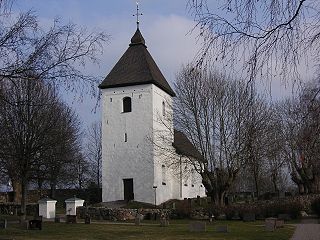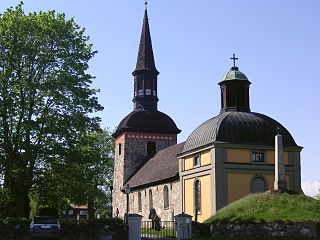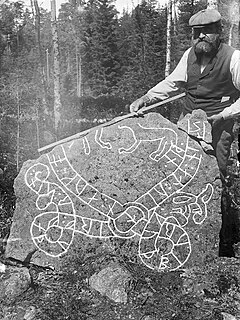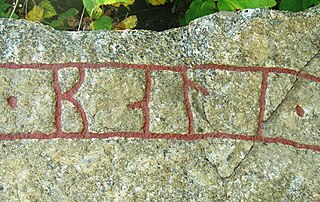
U 11 is the Rundata designation for a runestone that is located near the ruins of the old king's dwelling at Alsnö hus near Hovgården on the island of Adelsö in Sweden.

This runic inscription, designated as U Fv1976;107 under the Rundata catalog, is located at the Uppsala Cathedral in Uppsala, Sweden.

This Viking Age runestone, listed under Rundata as runic inscription U 489, was originally located in Morby, Uppland, Sweden, and is a memorial to a woman.

U 932 is the Rundata designation for a Viking Age runestone that was carved by the runemaster Åsmund and is located in Uppsala, Sweden.

Runic inscription U 934 is the Rundata catalog listing for a Viking Age runestone located in Uppsala, Sweden.

The Färentuna runestones are 11th century runestones labelled U 20, U 21, and U 22 in the Rundata catalog that are located in Färentuna, Uppland, Sweden. Runestones U 20 and U 21 were registered separately although they come from the same original runestone and consequently are called U 20/21. The runestone U 20/U 21 is probably most interesting as it, together with the Hillersjö stone and the Snottsta and Vreta stones, tells the story of the family of Gerlög and Inga. All of the Färentuna runestones are inscribed in the younger futhark.

The Näsby Runestone, designated as U 455 under the Rundata catalog, is a Viking Age memorial runestone that is located in Näsby, Uppland, Sweden.

The Lingsberg Runestones are two 11th-century runestones, listed as U 240 and U 241 in the Rundata catalog, and one fragment, U 242, that are engraved in Old Norse using the younger futhark. They are at the Lingsberg farm about 2 kilometres (1.2 mi) east of Vallentuna, which is about 24 kilometres (15 mi) north of the center of Stockholm, Stockholm County, Sweden, which was part of the former province of Uppland.

Adelsö Church is a church located on the Lake Mälaren island of Adelsö, in Ekerö Municipality in central eastern Sweden.

Uppland Runic Inscription 100 is the Rundata designation for a memorial runestone that is located in the forest where a path meets a bog near Skälby, which is about two kilometers northeast of Sollentuna, Stockholm County, Sweden, which was part of the historical province of Uppland.

This runic inscription, designated as U 839 in the Rundata catalog, is on a Viking Age memorial runestone located in Ryda kungsgård, which is about 6 kilometers north of Enköping, Uppsala County, Sweden, and in the historic province of Uppland.

The Lovö Runestones are five Viking Age memorial runestones that are located outside the Lovö church on the island of Lovön in Lake Mälaren, which is in Stockholm County, Sweden, and in the historic province of Uppland.

This runic inscription, designated as U 448 in the Rundata catalog, is on a Viking Age memorial runestone located in Harg, which is about 4 kilometers north of Märsta, Stockholm County, Sweden, which was in the historic province of Uppland.

The Gamla Turingevägen Inscriptions are two Viking Age memorial runic inscriptions and one image that are designated as Sö 311, Sö 312, and Sö 313 in the Rundata catalog, that are located in Södertälje, Stockholm County, Sweden, and in the historic province of Södermanland.

Runic inscription U 873 is the Rundata catalog number for a Viking Age memorial runestone that is located in Örsunda, which is about one kilometer west of Örsundsbro, Uppsala County, Sweden, which is in the historic province of Uppland.

The Björklinge runestones are five Viking Age memorial runestones designated in the Rundata catalog as U 1045, U 1046, U 1047, U 1048, and U 1050 that are located at the church in Björklinge, Uppsala County, Sweden, which is in the historic province of Uppland. In addition, there is a small fragment of a runestone with a partial runic text i * lit * rita * meaning "had erected" that has been given the catalog number U 1049.

Uppland Runic Inscription 993 or U 993 is the Rundata catalog number for a Viking Age memorial runestone located in Brunnby, which is one kilometer west of Gunsta, Uppsala County, Sweden, which was part of the historical province of Uppland.

Södermanland Runic Inscription 235 or Sö 235 is the Rundata listing for a Viking Age memorial runestone fragment that is located in Västerby, which is six kilometers southwest of Väländan, Stockholm County, Sweden, and in the historic province of Södermanland.

Uppland Runic Inscription 541 or U 541 is the Rundata catalog listing for a Viking Age memorial runestone which is located at the Husby-Sjuhundra church, which is five kilometers west of Norrtälje, Stockholm County, Sweden, and in the historic province of Uppland. The inscription is signed by the runemaster Öpir.

The Bolsta Runestones are two Viking Age memorial runestones and two fragments of a third that are located in Bolsta, which is on the east edge of Uppsala, Uppsala County, Sweden, and in the historic province of Uppland. One runestone is signed by the runemaster with the normalized name of Åsmund Kåresson and the other by the runemaster named Öpir.


























